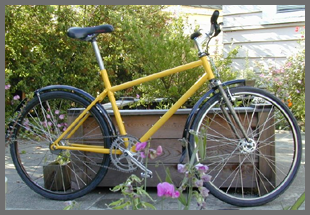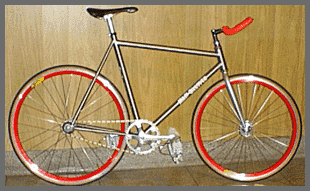by Greg Goode
It's like oranges and citrus fruits. All track bikes are fixed-gear bikes, but not vice versa.
What is a Fixed-Gear Bike?
Remember riding a tricycle? A fixed-gear bike is like that.
It has a direct-drive system between the pedals and the rear wheel.
If the pedals move, the rear wheel moves, either forwards or backwards.
And if the rear wheel moves, the pedals move. The upshot
is that the bike doesn't coast, not even downhill. If you ride 50 miles, you pedal 50 miles.
And fixed-gear bikes come in all shapes and sizes. They are put to various uses, such
as artistic performance, off-road, utility, cruisers, messengering, touring, and velodrome racing.
Fixes can have 3-speed handlebars, mustaches, or MTB bars. They can sport
front and rear brakes, fenders, panniers and other components. And a few fixes even have
more than one speed.
Virtually any bike can be converted into a fixed-geared bike. In fact
Sheldon Brown and
Fixed Innovations have webpages for just that purpose.
What is a Track Bike?
A track bike is a fixed-gear bike made for racing at the velodrome.
It has upright angles in the seat tube, head tube and fork. It is stiff,
light, strong, with a high gear for the velodrome. The few components it
does have are lightweight. There are no brakes, and usually no brake holes or
water bottle bosses or cable routings on the frame.
A track bike is a great street bike as well.
The track bike's wheelbase is short, and the rider's foot in the forward
position often overlaps the front tire. This is less an issue at the
track than on the street, where the rider has to turn the wheel slowly in traffic
to thread around pedestrians and cars at stoplights. But street riders soon
learn to "toe-up" or "toe-down" without a problem.
© Greg Goode, 2003

